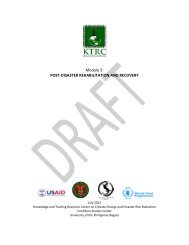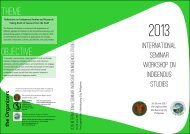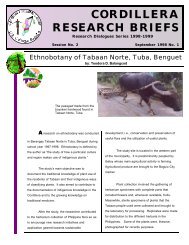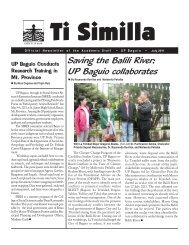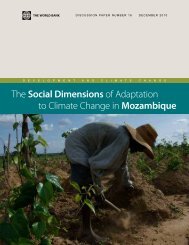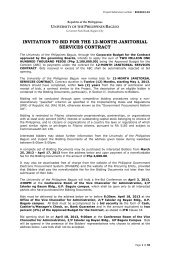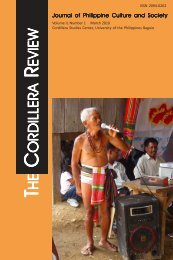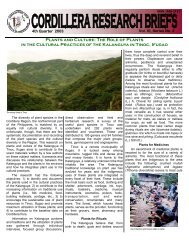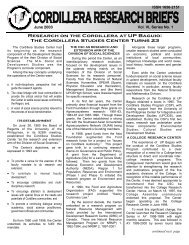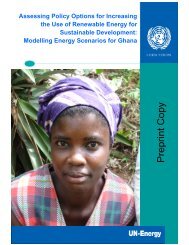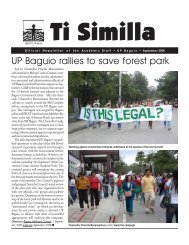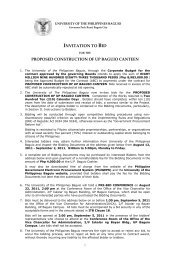Pambansang Summit sa W ambansang Summit sa W ... - UP Baguio
Pambansang Summit sa W ambansang Summit sa W ... - UP Baguio
Pambansang Summit sa W ambansang Summit sa W ... - UP Baguio
You also want an ePaper? Increase the reach of your titles
YUMPU automatically turns print PDFs into web optimized ePapers that Google loves.
Reclaiming <strong>Baguio</strong>, from page 6<br />
breathe in their most active time of the day, and by how much<br />
these levels exceed the accepted health standards? As long-time<br />
residents have become accustomed to the gradual worsening of<br />
the air quality of the city, the incremental changes might hardly<br />
be noticeable, and the current conditions are perceived as ‘normal’.<br />
It would take an outsider, or a new arrival, to ‘spot the big<br />
difference’. Yet an outsider who makes a loud noise about the<br />
air quality in <strong>Baguio</strong>, and displeases the local authorities, might<br />
be declared persona non grata.<br />
It is also probable that local authorities, well-meaning as they<br />
would be, might not themselves be informed of the gravity of<br />
the situation, and are convinced that the measures they are undertaking<br />
now to control the air pollution levels are quite sufficient.<br />
There are significant economic and social costs to the city<br />
and to its residents if the hazardous ambient air pollutants are<br />
not brought down. The mirror image of this is that there will be<br />
economic and social benefits to the city and to the local citizens,<br />
and even to visitors, if the air is transformed to become much<br />
cleaner and the environment becomes greener. What would it<br />
take to do so? Designing and implementing realistic measures to<br />
approach that cleaner air and greener environment will certainly<br />
entail costs – ‘there is no such thing as a free lunch.’ What feasible<br />
options are out there but might have not yet been thought of?<br />
Part 2 in May Ti Similla<br />
OFFICE OF PUBLIC AFFAIRS<br />
<strong>UP</strong> BAGUIO<br />
2600 BAGUIO CITY, PHILIPPINES<br />
ENTERED AS SECOND CLASS MAIL AT THE <strong>Baguio</strong> City Central Post<br />
Office, Upper Session Road, <strong>Baguio</strong> City WITH PERMIT NO. CAR-08.<br />
Report<br />
Colonialism and Gender, from page 7<br />
However, all is naught if they are not educated in superior conditions<br />
for it is only then that their higher faculties could be cultivated. Needless<br />
to <strong>sa</strong>y, this could only be done by religious evangelization.<br />
The missions were also replete with gender ideology as the education<br />
of girls was strictly guided and supervised for the purpose of training<br />
them to become Christian wives and for them to play a role in<br />
developing model Christian families. Accordingly, by doing so the girls<br />
could exercise their influence on their fellow Igorots. In addition, education<br />
of boys and girls was starkly different. Whereas boys were trained<br />
for local leadership or more generally trained for engagement in the<br />
public sphere, women were educated to be protectors of the private<br />
sphere: caring for the home and housework.<br />
Rovillos highlights how these missions were influenced by eugenics<br />
in their aim to produce a new generation of civilized individuals and<br />
this could only be done when educated Igorot men were united with<br />
educated Christian Igorot women. Women especially played a key role<br />
as they identified women to be the protectors of tradition compared to<br />
men. Thus, if they were able to train and educate the Igorot women,<br />
they had “won half the battle” of producing a civilized society.<br />
It is worth noting however that this task proved difficult as they<br />
were unable to get as many girls as they would have liked as the parents<br />
were reluctant to allow their children, especially the girls, to be educated<br />
in mission schools. Since women did most of the work, to allow<br />
the girls to study then was to rid the parents of much needed help. The<br />
effect of education on men and women was found to be skewed as men<br />
were more literate, were able to attain a more superior education and<br />
were more engaged in professional service compared to women.<br />
Rovillos also brings to light the fact that American colonialism introduced<br />
a gender ideology based on notions of a middle class, Christian<br />
family and that missionary effort and education had the greatest impact<br />
in the area of sexuality. Moreover, gender stereotypes on gender division<br />
of labour were introduced especially among the educated, but had<br />
little impact on the rest of the population.<br />
Ti Similla ISSN 0119-6634<br />
Published by the University of the Philippines <strong>Baguio</strong><br />
through the Office of Public Affairs<br />
E-mail: opa@upb.edu.ph<br />
<strong>UP</strong> <strong>Baguio</strong> website: www.upb.edu.ph<br />
VICTORIA RICO COSTINA, Editor<br />
GRACE SUBIDO, JIMMY FONG, RUTH TINDAAN, Associate Editors<br />
KAREN BALLADA, JENNIFER INOVERO, FARA MANUEL,<br />
DEEMSON MONES, BHAZEL PELICANO, ERLINDA PALAGANAS,<br />
SHEKINAH QUERI, PHOEBE RAMOS, MARIE CHRIS RAMOYA,<br />
LETICIA TOLENTINO, Staff Writers<br />
FREDERICK PEDREGOSA, Production<br />
The views and opinions expressed in TI SIMILLA do not neces<strong>sa</strong>rily reflect the collective<br />
stand of the academic staff or the official position of <strong>UP</strong> <strong>Baguio</strong>.





